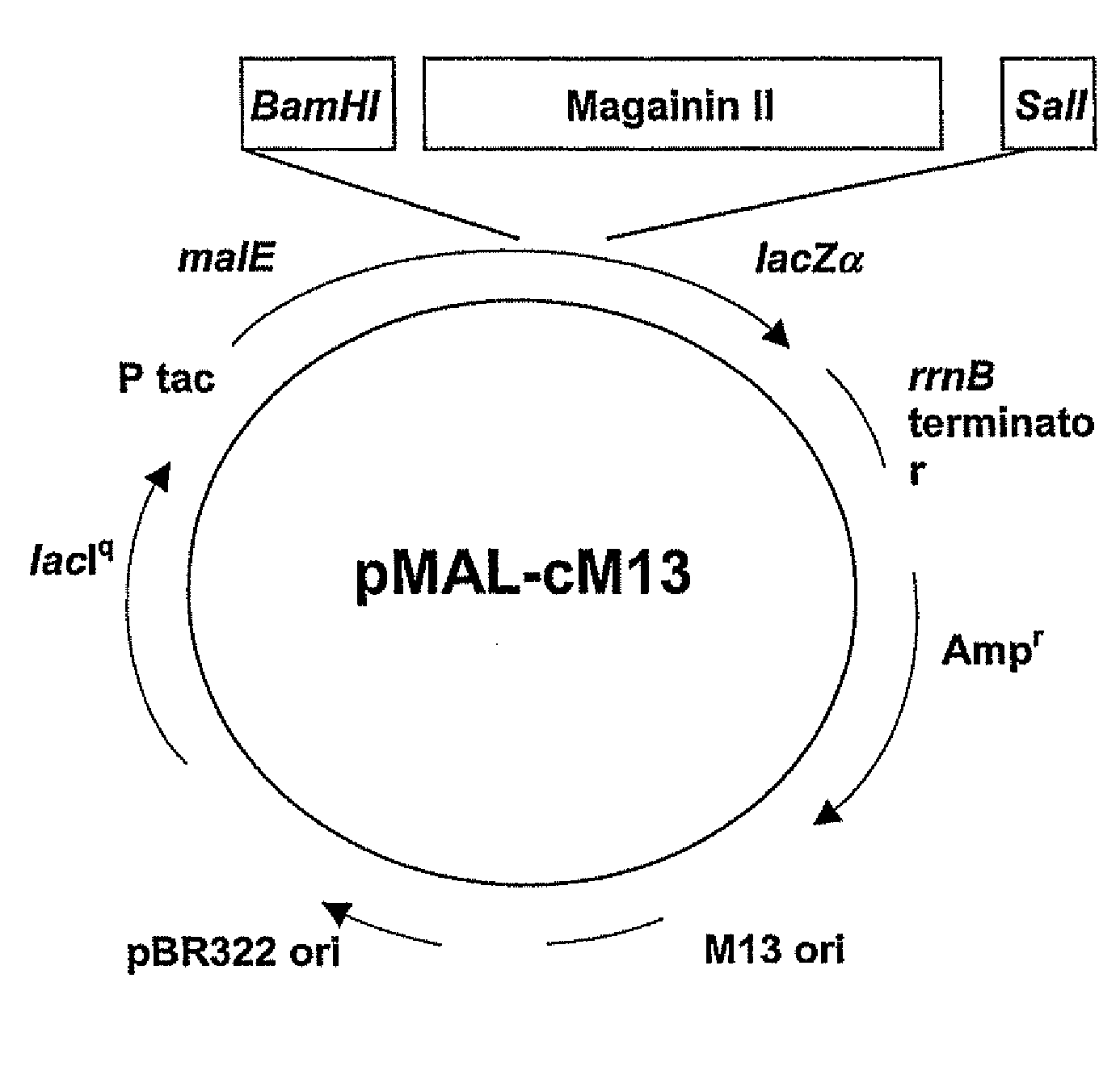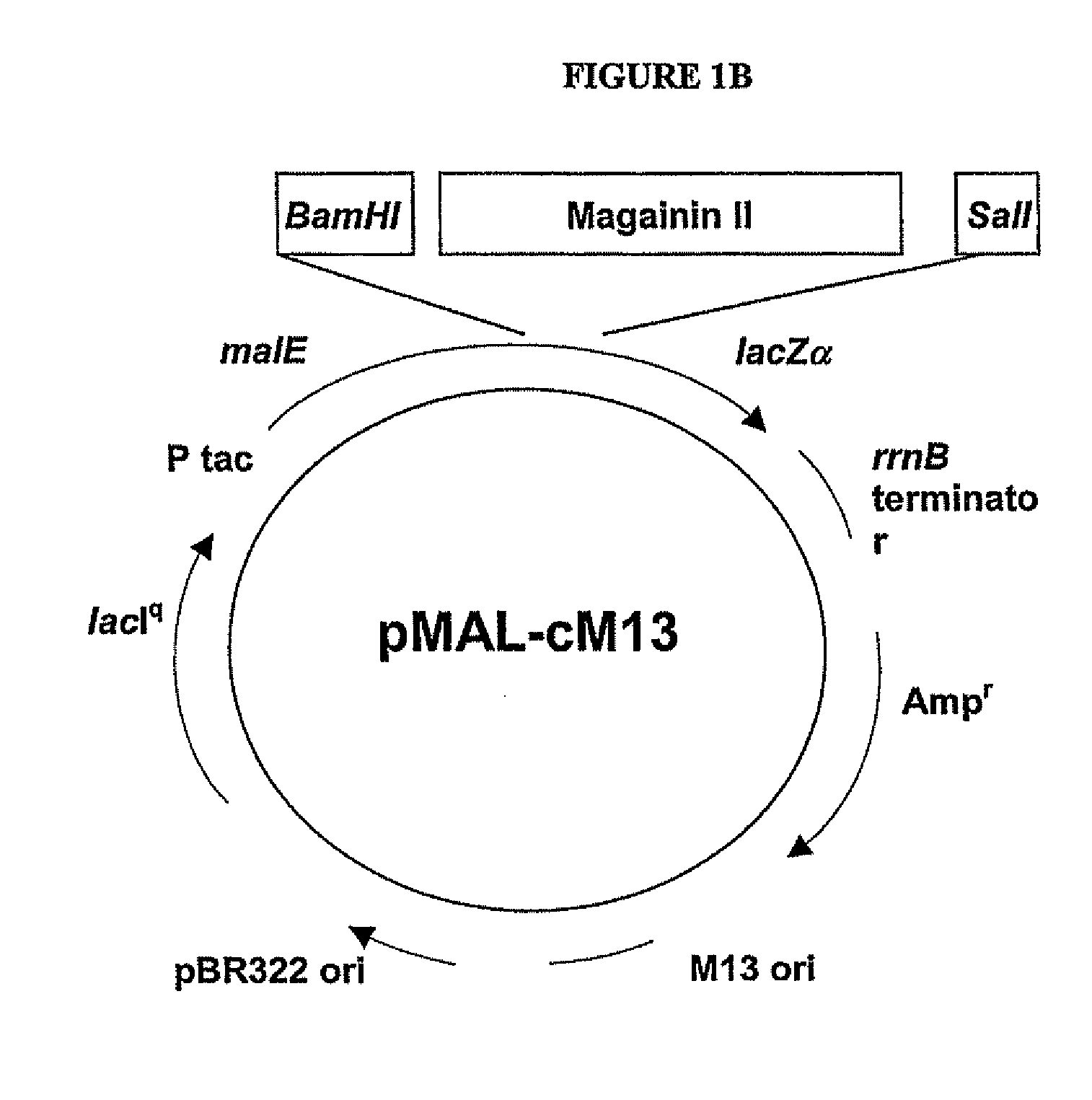Methods and Compositions for Increasing Membrane Permeability
a membrane permeability and composition technology, applied in the field of biotechnology, can solve the problems of not optimizing the cellular membrane system of the cell type for maximal production of a metabolite useful for human exploitation, not optimizing the cellular membrane system for maximal secretion of a desired substance, and not optimizing the cellular membrane system for maximal uptake of a substrate or a desired substance, so as to increase the number of nucleic acids and control the membrane permeability of the cell number
- Summary
- Abstract
- Description
- Claims
- Application Information
AI Technical Summary
Benefits of technology
Problems solved by technology
Method used
Image
Examples
example 1
MagII Cloning and Expression
[0122]The codon-optimized gene corresponding to the pore-forming peptide Mag II was synthesized along with the two restriction sites BamBl and Sail, and cloned into a cytoplasmic expression vector, c2x, as a fusion to the maltose binding protein (MaIE) (FIG. 1B). The fusion strategy was chosen as short peptides are particularly susceptible to proteases. The expression is under the control of the Tac promoter, inducible with IPTG. One clone, referred as cM13, was one of many clones obtained that had the correct sequence and was in frame with MaIE, and was chosen for further study.
[0123]The successful expression of MagII in E. coli was evident from the SDS-PAGE analysis (FIG. 2A). As shown in FIG. 2A, the fusion protein appeared as a strong band with the correct size. The expression apparently was dependent on the inducer concentration and increased with time. However, there was only a limited increase in expression at IPTG concentrations greater than 0.3 m...
example 2
MagII Expression on Growth
[0124]The effect of MagII expression on cell growth was investigated under different inducer concentrations. As shown in Table 3, at low inducer concentration (0.1 mM), the cells expressing MagII (E609 / cM13) exhibited almost identical growth rate as the control (E609 / c2x) with a similar doubling time (1.04 hr vs. 0.98 hr), and the final OD reached by the cells expressing MagII was 10% lower than that of the control. Together, these data suggest that there were no significant adverse growth effects when magainin expression was low. But as IPTG concentration increased to 0.3 mM, the magainin expression exerted a negative effect on cell growth, increasing its doubling time significantly (1.52 hr. vs. 0.96 hr). However, despite the significant reduction in growth rate, the final OD was only reduced by about 12%. Further increase of IPTG concentration to 0.5 mM did not seem to reduce the growth rate further and the final OD reached was similar. This can be expla...
example 3
Magainin II Expression Increases the Permeability of the Outer Membrane.
[0125]The alteration of the outer membrane permeability due to MagII expression was analyzed using a fluorescent probe, 1-N-phenylnaphthylamine (NPN). The uptake of NPN is normally blocked by an intact outer membrane. It fluoresces weakly in an aqueous environment; but once it has penetrated the outer membrane through a permeablizing mechanism, it gives a strong signal in a hydrophobic membrane (phospholipid) environment. This property is often exploited to detect the integrity of the outer membrane and measure its permeability (Helander and Mattila-Sandholm, 2000). Upon addition of NPN, the cells expressing MagII gave much stronger fluorescent signals than those not expressing the peptide. Subtracting the background reading, the NPN uptake factor was calculated as a basis for a quantitative comparison (Table 4). The uptake factor of NPN for cells expressing the peptide was about 4 times higher than the control,...
PUM
| Property | Measurement | Unit |
|---|---|---|
| interior diameter | aaaaa | aaaaa |
| area | aaaaa | aaaaa |
| area | aaaaa | aaaaa |
Abstract
Description
Claims
Application Information
 Login to View More
Login to View More - R&D
- Intellectual Property
- Life Sciences
- Materials
- Tech Scout
- Unparalleled Data Quality
- Higher Quality Content
- 60% Fewer Hallucinations
Browse by: Latest US Patents, China's latest patents, Technical Efficacy Thesaurus, Application Domain, Technology Topic, Popular Technical Reports.
© 2025 PatSnap. All rights reserved.Legal|Privacy policy|Modern Slavery Act Transparency Statement|Sitemap|About US| Contact US: help@patsnap.com



